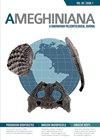Rich and Specialized Plant-Insect Associations in a Middle–Late Paleocene (58–60 Ma) Neotropical Rainforest (Bogotá Formation, Colombia)
IF 1.5
4区 地球科学
Q3 PALEONTOLOGY
引用次数: 7
Abstract
Abstract. Plant predation by insects is a major driver of high plant diversity in modern tropical forests. Previous reports of leaf damage in middle–late Paleocene Neotropical rainforests of Cerrejón, Colombia, show that leaf herbivory was abundant but of low diversity, mainly inflicted by generalized feeders. Here, we present and describe plant-insect associations in leaf fossils from the middle–late Paleocene Bogotá Formation, central Colombia, to test whether the high abundance and low richness of insect damage typified early evolving Neotropical rainforests. The Bogotá flora records the highest richness and frequency of insect-damage associations among comparable Paleocene floras in North America, Patagonia, and Europe, as well as the highest number of leaf mines and galling associations. These results indicate that by the middle–late Paleocene, plant-insect herbivore interactions were much more intense and host-specialized in Neotropical rainforests of the Bogotá region than elsewhere. The rich and frequent galling associations, a distinctive feature of the Bogotá flora, are consistent with the preferential use of canopy leaves by galling insects seen in modern Neotropical rainforests. Our results also indicate differences in plant-insect associations among Paleocene Neotropical rainforests, perhaps reflecting a geographically heterogeneous ecological recovery from the end-Cretaceous ecological crisis. Plant insect-associations in the Bogotá flora also suggest a deep historical context for negative density-dependence as a potential driver (and maintainer) of the high plant diversity observed in modern Neotropical rainforests.古新世中晚期(58–60 Ma)新热带雨林中丰富而专门的植物昆虫群落(哥伦比亚波哥大组)
摘要昆虫对植物的捕食是现代热带森林植物多样性高的主要驱动因素。先前关于哥伦比亚Cerrejón古新世中晚期新热带雨林叶片受损的报告表明,叶片草食性丰富,但多样性低,主要由广泛的食草动物造成。在这里,我们展示并描述了哥伦比亚中部古新世中晚期波哥大组的叶化石中的植物-昆虫组合,以测试昆虫破坏的高丰度和低丰富度是否代表了早期进化的新热带雨林。在北美、巴塔哥尼亚和欧洲的可比古新世植物群中,波哥大植物群记录了昆虫损伤关联的最高丰富度和频率,以及叶矿和擦伤关联的最高数量。这些结果表明,到古新世中晚期,植物-昆虫-食草动物的相互作用在波哥大地区的新热带雨林中比其他地方更加强烈,宿主也更加特殊。波哥大植物群的一个显著特征是,这种丰富而频繁的觅食联想与现代新热带雨林中常见的觅食昆虫对遮篷叶的优先使用相一致。我们的研究结果还表明,古新世-新热带雨林之间的植物-昆虫组合存在差异,这可能反映了白垩纪末生态危机后的地理异质性生态恢复。波哥大植物区系中的植物-昆虫协会也表明,负密度依赖是现代新热带雨林中观察到的高植物多样性的潜在驱动因素(和维持因素),这是一个深刻的历史背景。
本文章由计算机程序翻译,如有差异,请以英文原文为准。
求助全文
约1分钟内获得全文
求助全文
来源期刊

Ameghiniana
地学-古生物学
CiteScore
2.50
自引率
10.00%
发文量
21
期刊介绍:
Ameghiniana is a bimonthly journal that publishes original contributions on all disciplines related to paleontology, with a special focus on the paleontology of Gondwana and the biotic history of the southern hemisphere. Published yearly since 1957, it has undoubtedly become the main palaeontological publication from Latin America. Ameghiniana has recently broadened its editorial board, reorganized its production process, and increased to a bimonthly frequency, which resulted in a significant decrease in the turn around time.
 求助内容:
求助内容: 应助结果提醒方式:
应助结果提醒方式:


